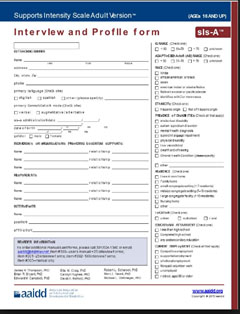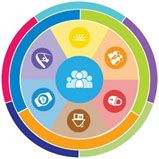
Supports Intensity Scale ® (SIS®)
The Supports Intensity Scale ® (SIS®) is the tool DDD is using to understand the kind of supports people need, based on their individual circumstances, to be successful at home and in the community. It is an assessment tool developed by the American Association on Intellectual and Developmental Disabilities (AAIDD) that measures the type and amount of support that a person with intellectual and/or developmental disabilities (I/DD) needs to be successful.
The SIS measures a person’s support needs in these areas:
- Home Living
- Community Living
- Lifelong Learning
- Employment
- Health and Safety
- Social Activities
- Exceptional Medical Support Needs
- Exceptional Behavioral Support Needs

SIS Assessment Interview
SIS assessments are conducted during a face-to-face interview by a SIS Assessor who has been trained by AAIDD. The SIS Assessor will not be the person’s case manager. At least two people who understand the person’s support needs must stay for the entire interview. This ensures the assessor is given the most accurate information about the person’s needs and abilities that will result in the person receiving the correct level of support to improve their quality of life. People who receive services are strongly encouraged to be at their SIS interview.
Attendees can be:
- Person for whom the SIS is being conducted
- Parents/guardian, spouse, or other family members
- Direct support staff from the person’s home, day program, or employment
- Case managers
- Friends, neighbors or community members who know the person well
After the interview, the SIS assessment results are made available to the person or their family member upon request.
What to Expect in a SIS Assessment Interview
Before the interview begins, the SIS Assessor will explain the interview process and answer questions from the attendees. The Assessor will make sure that all attendees are ready to begin the interview. A SIS interview usually takes about three or more hours to complete. The SIS Assessor will ask about activities at home, in the community, and with friends and family. The Assessor will need to know how much support is needed for the person to fully engage in these activities. During the interview, the Assessor might ask the attendees to imagine the person doing things he/she has not done before. This is a chance to think about different goals the person may achieve.
For each item, the SIS Assessor will ask:
- How often do you need support?
- How much support do you need?
- What type of support do you need?
In order to ensure the correct amount and type of support is provided, the attendees need to answer the questions honestly and as thoroughly as possible. The SIS Assessor will document the responses of the attendees throughout the interview.
How DDD is Using the SIS
 The SIS will help the Individualized Service Plan (ISP) team to understand what supports are needed for the person to achieve a richer, fuller life. This will result in a more accurate and effective ISP. It’s important to understand what supports people need to live a good life in their community. Information from the SIS helps with this discovery process. It identifies the types and amount of support each person needs to be successful.
The SIS will help the Individualized Service Plan (ISP) team to understand what supports are needed for the person to achieve a richer, fuller life. This will result in a more accurate and effective ISP. It’s important to understand what supports people need to live a good life in their community. Information from the SIS helps with this discovery process. It identifies the types and amount of support each person needs to be successful.
In Hawaii, the SIS is being used in two ways:
- Develop more effective person-centered service plans (ISP), and
- To determine the level of supports (1-7), based on level of need.
When certain questions on the SIS indicate an individual has extraordinary medical or behavioral needs, SIS Assessors will ask a standard set of supplemental questions to gather additional information about these needs.
Phase-in of SIS Assessments
The SIS will be conducted every 3 years for every person 16 years and older receiving DDD services.
In the first year, starting in July 2017, the first group of people to receive the SIS, and have the information about what they need used in their individual service plans, are people who live in licensed or certified residential settings. The first group is called Cohort 1.
In the second year, starting July 2018, people who live at home and also receive Adult Day Health (ADH) services will begin having SIS information used in their ISPs. This second group is called Cohort 2.
In the third year, starting July 2019, people who live at home and do not attend ADH, but receive other services will begin having SIS information used in their ISPs. This third group is called Cohort 3.
If you have questions about the SIS assessment or supports level, contact your case manager.